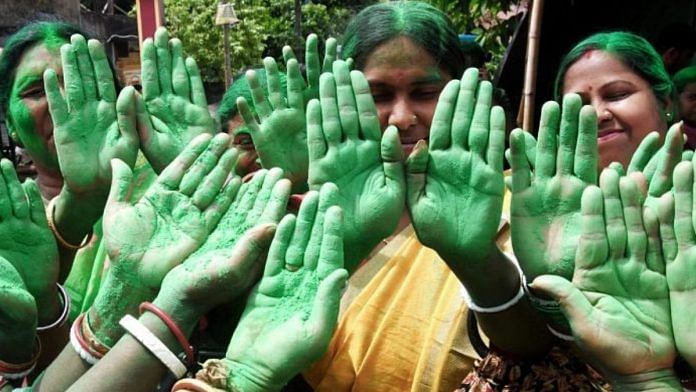If you thought Bengalis are only about rosogolla, maacher jhol, and Rabindra Sangeet, think again. Another Bengali passion is the bhooter golpo—spine-tingling ghost stories written by eminent writers, Tagore included. Satyajit Ray, too, wrote some ghostly tales and even lent his voice to Bhooter Raja, or King of Ghosts — a character in the children’s film Goopy Gyne Bagha Byne. Anik Dutta’s Bhooter Bhabishyat broke the box office in 2012, and each Sunday, radio star Mir and team draw millions of Bengalis to brilliantly dramatised ghost stories: Sunday Suspense. If you have even rudimentary Bengali, tune in. It’s a treat.
No idea if she listens to the show, but Mamata Banerjee—well-versed in Bengali literature and the author of over a hundred books of prose, poetry, and autobiography herself—has not written a ghost story yet. This gap in her literary oeuvre may have been at the back of her mind. So, when a quirk was spotted in the state’s electoral rolls—Electronic Photo Identity Cards (EPICs) with the exact same numbers for voters in Bengal and, mostly, Haryana—she lost no time in giving the glitch a name her gut must have told her Bengalis would go ga ga about: ghost voters.
They did.
Immediately after Banerjee gave it that brand name on 27 February, swarms of Trinamool Congress workers turned ghost-hunters and fanned out into villages across West Bengal, looking for duplicate EPICs that they claimed the BJP, in cahoots with the Election Commission of India (ECI), had planted in the electoral rolls with an eye on the 2026 Assembly elections. Not to be outdone, BJP workers also set out hunting for ghost voters they suspected the TMC had deployed, determined to play ghost voter busters.
West Bengal has 7.6 crore voters. At last count, the TMC publicly listed nine cases of duplicate EPIC cards in the state. EC officials told me that, much before the TMC raised the issue, around 8,000 EPIC numbers had been identified in Bengal with duplicates in Haryana. They claimed the duplicates—spotted over a period of 15 years—may have crept in when the electoral rolls migrated from manual or semi-manual to a fully computerised system.
Now, the EC has tweaked ERONET, the web-based electoral roll management system. Electoral Registration Officers (EROs) in every Assembly constituency can now find duplicate EPICs anywhere in the country with just one click of the mouse. Another big move to make the electoral list foolproof is the recent decision to link Aadhaar and EPIC.
But can the EC ever produce a truly flawless voter list? Or, as any bhoot-fearing Bengali would ask, is there a ghost in the mustard itself—shorsher moddhey bhoot? The idiom harks back to the old practice of exorcists throwing mustard seeds into a fire to chase ghosts or spirits out of a “possessed” person. The question is, can you fix a flaw if the flaw lies within?
Also Read: Ghost voters, duplicate IDs, model code double standards—EC’s denial and damage control
Of EROs, BLOs, and BLAs
There’s nothing supernatural about the procedure to revise voter rolls. Electoral Registration Officers (EROs)—state government employees posted in each assembly constituency—send out Booth Level Officers (BLOs), usually Anganwadi workers and the like, to physically verify existing voters and delete the names of the dead or those who’ve shifted away. West Bengal has 80,633 booths, and roll revision is a continuous process that shifts into high gear in November. The updated rolls are published in January.
This is not just a bureaucratic exercise. Political parties are the main stakeholders and active participants in the entire process. All recognised state parties—six in West Bengal—can and do deploy party workers called Block Level Agents (BLAs) to scan the voter list and report irregularities, if any. BLAs are most likely to know each and every voter in their assigned area.
How then, despite BLAs, BLOs and EROs, do ghost voters sneak into the voter lists? It is truly spooky. How real are these ghost voters? Are they real or mythical? Drummed up to grab headlines, full of sound and fury signifying nothing? It is also spooky that though duplicate cards were spotted in other states too, it is only in West Bengal that ghost voters were turned into political weaponry.
Some observers have labelled them weapons of mass distraction.
The Election Commission cannot shrug off responsibility for the fiasco and must plug all loopholes. But political parties play a big role in voter list revision. If, despite their involvement, there are ghost voters in the list, then surely the buck must stop at their doors too.
Also Read: Bengal mustn’t gloat over EAC-PM migration report. Skilled labour still moving to other states
Stranger than fiction
There are more things in heaven and earth than are dreamt of in your philosophy. So said Hamlet, roughly, in the eponymous play starring the ghost of his father. One of those “more things” that the EC routinely deals with is Demographically Similar Entries (DSEs). That’s when two genuine voters have the same name, same father’s name, and even the same age on their EPICs.
No wonder the ghost voter bogey is giving ghost story-loving Bengalis the goosebumps.
And there are more skeletons in the cupboard. In the last year, the Election Commission deleted over 9 lakh names from the West Bengal voter list, mostly of people who had died or shifted. But there were a number of DSEs too. In 2022, across the country, the EC struck off or corrected 10 million duplicate entries—a mix that included DSEs and, hold your breath, PSEs: Photographically Similar Entries.
Real or mythical, this debate on ghost voters will possibly come up every time elections do.
Routine pre-election political shenanigans, really. But who could have ever imagined that the humdrum voter list could be such a rich source of dramatic material for the next ghostly blockbuster.
Anik Dutta, Mir, are you listening?
Monideepa Banerjie is a senior journalist based in Kolkata. She tweets @Monideepa62. Views are personal.
(Edited by Asavari Singh)






